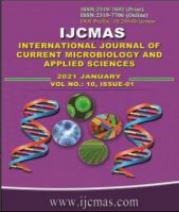


 National Academy of Agricultural Sciences (NAAS)
National Academy of Agricultural Sciences (NAAS)

|
PRINT ISSN : 2319-7692
Online ISSN : 2319-7706 Issues : 12 per year Publisher : Excellent Publishers Email : editorijcmas@gmail.com / submit@ijcmas.com Editor-in-chief: Dr.M.Prakash Index Copernicus ICV 2018: 95.39 NAAS RATING 2020: 5.38 |
The present research work comprises twenty one genotypes of sesame were evaluated in a randomized complete block design (RCBD) with three replications at Agricultural Research Station, Navgaon (Alwar) during Kharif 2019. The presence of genetic divergence among these lines was observed by Mahalanobis’s D2 statistic. All the accesses were grouped into five distinct clusters. The highest number of genotypes appeared in cluster I (14) followed by cluster II (3) and cluster III (2) while the lowest numbers of entries were reported in cluster IV (1) & V (1). Principal component analysis (PCA) indicated that the three principal components (PC1 to PC3) showed 67.43 per cent of the total variability. The first principal component had high positive loading for seed yield per plant, capsules bearing length and seeds per capsule which contributed more to the diversity. The second principal component had high loading for days to maturity, number of primary branches per plant and 1000-seed weight. The genotypes viz., RT-346, GT-10 and EC-351880 were identified as the most diverse genotypes, based on component scores and these genotypes could be utilized as parents in hybridization programme.
 |
 |
 |
 |
 |